Quantifying Forest Fire and Post-Fire Vegetation Recovery in the Daxin’anling Area of Northeastern China Using Landsat Time-Series Data and Machine Learning
Abstract
1. Introduction
2. Materials and Methods
2.1. Study Area
2.2. Data and Preprocessing
2.3. VCT-Based Forest Disturbance Mapping and Validation
2.4. Burned Area Extraction Using the VCT Products and SVM Algorithm
2.5. Post-Fire Vegetation Recovery Modeling
3. Results
3.1. Forest Disturbance Mapping and Validation
3.2. Fire Disturbance Mapping and Validation
3.3. Model Fitting and Validation
4. Discussion
4.1. Fire Disturbance and Recovery
4.2. Post-Fire Recovery Response to Climate
4.3. Vegetation Recovery Modeling
4.4. Limitations and Future Improvements
5. Conclusions
Author Contributions
Funding
Data Availability Statement
Acknowledgments
Conflicts of Interest
References
- Kelly, L.T.; Brotons, L. Using fire to promote biodiversity. Science 2017, 355, 1264–1265. [Google Scholar] [CrossRef] [PubMed]
- Westerling, A.L.; Hidalgo, H.G.; Cayan, D.R.; Swetnam, T.W. Warming and Earlier Spring Increase Western U.S. Forest Wildfire Activity. Science 2006, 313, 940–943. [Google Scholar] [CrossRef] [PubMed]
- Knorr, W.; Jiang, L.; Arneth, A. Climate, CO2 and human population impacts on global wildfire emissions. Biogeosciences 2016, 13, 267–282. [Google Scholar] [CrossRef]
- Sugihara, N.G.; Van Wagtendonk, J.W.; Shaffer, K.E.; Fites-Kaufman, J.; Thode, A.E. Fire in California’s Ecosystems; University of California Press: Oakland, CA, USA, 2006; p. 596. [Google Scholar]
- Chuvieco, E.; Mouillot, F.; van der Werf, G.R.; Miguel, J.S.; Tanase, M.; Koutsias, N.; García, M.; Yebra, M.; Padilla, M.; Gitas, I.; et al. Historical background and current developments for mapping burned area from satellite Earth observation. Remote. Sens. Environ. 2019, 225, 45–64. [Google Scholar] [CrossRef]
- Ramo, R.; Chuvieco, E. Developing a Random Forest Algorithm for MODIS Global Burned Area Classification. Remote. Sens. 2017, 9, 1193. [Google Scholar] [CrossRef]
- Chuvieco, E.; Martínez, S.; Román, M.V.; Hantson, S.; Pettinari, M.L. Integration of ecological and socio-economic factors to assess global vulnerability to wildfire. Glob. Ecol. Biogeogr. 2014, 23, 245–258. [Google Scholar] [CrossRef]
- Chen, J.M.; Zhao, P.; Guo, X.Y. Numerical simulation of the impact of changes in the vegetation in the western China on the summer climate over the northern China. Acta Meteorol. Sin. 2010, 68, 173–181. (In Chinese) [Google Scholar]
- Jeong, S.-J.; Ho, C.-H.; Park, T.-W.; Kim, J.; Levis, S. Impact of vegetation feedback on the temperature and its diurnal range over the Northern Hemisphere during summer in a 2 × CO2 climate. Clim. Dyn. 2011, 37, 821–833. [Google Scholar] [CrossRef]
- Jiang, B.; Liang, S. Improved vegetation greenness increases summer atmospheric water vapor over Northern China. J. Geophys. Res. Atmos. 2013, 118, 8129–8139. [Google Scholar] [CrossRef]
- Zou, Y.; Wang, Y.; Qian, Y.; Tian, H.; Yang, J.; Alvarado, E. Using CESM-RESFire to understand climate–fire–ecosystem interactions and the implications for decadal climate variability. Atmospheric Chem. Phys. Discuss. 2020, 20, 995–1020. [Google Scholar] [CrossRef]
- Furyaev, V.; Vaganov, E.; Tchebakova, N.; Valendik, E. Effects of Fire and Climate on Successions and Structural Changes in The Siberian Boreal Forest. Eurasian J. For. Res.-Hokkaido Univ. 2001, 2, 1–15. [Google Scholar]
- Arthur, A.D.; Catling, P.C.; Reid, A. Relative influence of habitat structure, species interactions and rainfall on the post-fire population dynamics of ground-dwelling vertebrates. Austral Ecol. 2012, 37, 958–970. [Google Scholar] [CrossRef]
- Gimeno-García, E.; Andreu, V.; Rubio, J.L. Influence of vegetation recovery on water erosion at short and medium-term after experimental fires in a Mediterranean shrubland. Catena 2007, 69, 150–160. [Google Scholar] [CrossRef]
- Gilroy, J.J.; Woodcock, P.; Edwards, F.A.; Wheeler, C.; Baptiste, B.L.G.; Uribe, C.A.M.; Haugaasen, T.; Edwards, D.P. Cheap carbon and biodiversity co-benefits from forest regeneration in a hotspot of endemism. Nat. Clim. Chang. 2014, 4, 503–507. [Google Scholar] [CrossRef]
- Shatford, J.P.A.; Hibbs, D.E.; Puettmann, K.J. Conifer regeneration after forest fire in the Klamath-Siskiyous: How much, how soon? J. For. 2007, 105, 139–146. [Google Scholar]
- Bassett, M.; Leonard, S.W.; Chia, E.K.; Clarke, M.F.; Bennett, A.F. Interacting effects of fire severity, time since fire and topography on vegetation structure after wildfire. For. Ecol. Manag. 2017, 396, 26–34. [Google Scholar] [CrossRef]
- Marlon, J.R.; Bartlein, P.J.; Daniau, A.-L.; Harrison, S.P.; Maezumi, S.Y.; Power, M.J.; Tinner, W.; Vanniére, B. Global biomass burning: A synthesis and review of Holocene paleofire records and their controls. Quat. Sci. Rev. 2013, 65, 5–25. [Google Scholar] [CrossRef]
- Lydersen, J.M.; North, M.P.; Collins, B.M. Severity of an uncharacteristically large wildfire, the Rim Fire, in forests with relatively restored frequent fire regimes. For. Ecol. Manag. 2014, 328, 326–334. [Google Scholar] [CrossRef]
- Mitri, G.; Gitas, I. Mapping Postfire Vegetation Recovery Using EO-1 Hyperion Imagery. IEEE Trans. Geosci. Remote. Sens. 2009, 48, 1613–1618. [Google Scholar] [CrossRef]
- Townshend, J.R.; Masek, J.G.; Huang, C.; Vermote, E.F.; Gao, F.; Channan, S.; Sexton, J.O.; Feng, M.; Narasimhan, R.; Kim, D.; et al. Global characterization and monitoring of forest cover using Landsat data: Opportunities and challenges. Int. J. Digit. Earth 2012, 5, 373–397. [Google Scholar] [CrossRef]
- João, T.; João, G.; Bruno, M.; João, H. Indicator-based assessment of post-fire recovery dynamics using satellite NDVI time-series. Ecol. Indic. 2018, 89, 199–212. [Google Scholar] [CrossRef]
- Shen, W.; Li, M.; Huang, C.; He, T.; Tao, X.; Wei, A. Local land surface temperature change induced by afforestation based on satellite observations in Guangdong plantation forests in China. Agric. For. Meteorol. 2019, 276, 107641. [Google Scholar] [CrossRef]
- Li, M.; Huang, C.; Zhu, Z.; Shi, H.; Lu, H.; Peng, S. Assessing rates of forest change and fragmentation in Alabama, USA, using the vegetation change tracker model. For. Ecol. Manag. 2009, 257, 1480–1488. [Google Scholar] [CrossRef]
- Zhao, F.; Huang, C.; Zhu, Z. Use of Vegetation Change Tracker and Support Vector Machine to Map Disturbance Types in Greater Yellowstone Ecosystems in a 1984–2010 Landsat Time Series. IEEE Geosci. Remote. Sens. Lett. 2015, 12, 1650–1654. [Google Scholar] [CrossRef]
- Tang, D.; Fan, H.; Yang, K.; Zhang, Y. Mapping forest disturbance across the China–Laos border using annual Landsat time series. Int. J. Remote. Sens. 2018, 40, 2895–2915. [Google Scholar] [CrossRef]
- Loboda, T.; Zhang, Z.; O’Neal, K.; Sun, G.; Csiszar, I.; Shugart, H.; Sherman, N. Reconstructing disturbance history using satellite-based assessment of the distribution of land cover in the Russian Far East. Remote. Sens. Environ. 2012, 118, 241–248. [Google Scholar] [CrossRef]
- Thomas, N.E.; Huang, C.; Goward, S.N.; Powell, S.; Rishmawi, K.; Schleeweis, K.; Hinds, A. Validation of North American Forest Disturbance dynamics derived from Landsat time series stacks. Remote. Sens. Environ. 2011, 115, 19–32. [Google Scholar] [CrossRef]
- Chu, T.; Guo, X. Remote Sensing Techniques in Monitoring Post-Fire Effects and Patterns of Forest Recovery in Boreal Forest Regions: A Review. Remote. Sens. 2013, 6, 470–520. [Google Scholar] [CrossRef]
- Meng, R.; Dennison, P.E.; Huang, C.; Moritz, M.A.; D’Antonio, C. Effects of fire severity and post-fire climate on short-term vegetation recovery of mixed-conifer and red fir forests in the Sierra Nevada Mountains of California. Remote Sens. Environ. 2015, 171, 311–325. [Google Scholar] [CrossRef]
- Meng, R.; Wu, J.; Zhao, F.; Cook, B.D.; Hanavan, R.P.; Serbin, S.P. Measuring short-term post-fire forest recovery across a burn severity gradient in a mixed pine-oak forest using multi-sensor remote sensing techniques. Remote. Sens. Environ. 2018, 210, 282–296. [Google Scholar] [CrossRef]
- Certini, G. Effects of fire on properties of forest soils: A review. Oecologia 2005, 143, 1–10. [Google Scholar] [CrossRef]
- Masek, J.; Vermote, E.; Saleous, N.; Wolfe, R.; Hall, F.; Huemmrich, K.; Gao, F.; Kutler, J.; Lim, T.-K. A Landsat Surface Reflectance Dataset for North America, 1990–2000. IEEE Geosci. Remote. Sens. Lett. 2006, 3, 68–72. [Google Scholar] [CrossRef]
- Li, M.; Huang, C.; Shen, W.; Ren, X.; Lv, Y.; Wang, J.; Zhu, Z. Characterizing long-term forest disturbance history and its drivers in the Ning-Zhen Mountains, Jiangsu Province of eastern China using yearly Landsat observations (1987–2011). J. For. Res. 2016, 27, 1329–1341. [Google Scholar] [CrossRef]
- Huang, C.; Song, K.; Kim, S.; Townshend, J.R.; Davis, P.; Masek, J.G.; Goward, S.N. Use of a dark object concept and support vector machines to automate forest cover change analysis. Remote. Sens. Environ. 2008, 112, 970–985. [Google Scholar] [CrossRef]
- Tucker, C.J. Red and photographic infrared linear combinations for monitoring vegetation. Remote. Sens. Environ. 1979, 8, 127–150. [Google Scholar] [CrossRef]
- Epting, J.; Verbyla, D. Landscape-level interactions of prefire vegetation, burn severity, and postfire vegetation over a 16-year period in interior Alaska. Can. J. For. Res. 2005, 35, 1367–1377. [Google Scholar] [CrossRef]
- Wilson, E.H.; Sader, S.A. Detection of forest harvest type using multiple dates of Landsat TM imagery. Remote Sens. Environ. 2002, 80, 385–396. [Google Scholar] [CrossRef]
- Wulder, M. Optical remote-sensing techniques for the assessment of forest inventory and biophysical parameters. Prog. Phys. Geogr. Earth Environ. 1998, 22, 449–476. [Google Scholar] [CrossRef]
- Stroppiana, D.; Bordogna, G.; Carrara, P.; Boschetti, M.; Brivio, P. A method for extracting burned areas from Landsat TM/ETM+ images by soft aggregation of multiple Spectral Indices and a region growing algorithm. ISPRS J. Photogramm. Remote. Sens. 2012, 69, 88–102. [Google Scholar] [CrossRef]
- Crist, E.P.; Cicone, R.C. A Physically-Based Transformation of Thematic Mapper Data-The TM Tasseled Cap. IEEE Trans. Geosci. Remote Sens. 1984, 22, 256–263. [Google Scholar] [CrossRef]
- Van Leeuwen, W.J.D.; Casady, G.M.; Neary, D.G.; Bautista, S.; Alloza, J.A.; Carmel, Y.; Wittenberg, L.; Malkinson, D.; Orr, B.J. Monitoring post-wildfire vegetation response with remotely sensed time-series data in Spain, USA and Israel. Int. J. Wildland Fire 2010, 19, 75–93. [Google Scholar] [CrossRef]
- Kennedy, R.E.; Yang, Z.; Cohen, W.B.; Pfaff, E.; Braaten, J.; Nelson, P. Spatial and temporal patterns of forest disturbance and regrowth within the area of the Northwest Forest Plan. Remote Sens. Environ. 2012, 122, 117–133. [Google Scholar] [CrossRef]
- White, J.C.; Wulder, M.A.; Hermosilla, T.; Coops, N.C.; Hobart, G.W. A nationwide annual characterization of 25 years of forest disturbance and recovery for Canada using Landsat time series. Remote. Sens. Environ. 2017, 194, 303–321. [Google Scholar] [CrossRef]
- Pickell, P.D.; Hermosilla, T.; Frazier, R.J.; Coops, N.C.; Wulder, M.A. Forest recovery trends derived from Landsat time series for North American boreal forests. Int. J. Remote. Sens. 2015, 37, 138–149. [Google Scholar] [CrossRef]
- Huang, C.; Goward, S.N.; Masek, J.G.; Thomas, N.; Zhu, Z.; Vogelmann, J.E. An automated approach for reconstructing recent forest disturbance history using dense Landsat time series stacks. Remote. Sens. Environ. 2010, 114, 183–198. [Google Scholar] [CrossRef]
- Breiman, L. Random forests. Mach. Learn. 2001, 45, 5–32. [Google Scholar] [CrossRef]
- García-Gutiérrez, J.; Martínez-Álvarez, F.; Troncoso, A.; Riquelme, J.C. A comparison of machine learning regression techniques for LiDAR-derived estimation of forest variables. Neurocomputing 2015, 167, 24–31. [Google Scholar] [CrossRef]
- Feng, Y.; Lu, D.; Chen, Q.; Keller, M.; Moran, E.; Dos-Santos, M.N.; Bolfe, E.L.; Batistella, M. Examining effective use of data sources and modeling algorithms for improving biomass estimation in a moist tropical forest of the Brazilian Amazon. Int. J. Digit. Earth 2017, 50, 1–21. [Google Scholar] [CrossRef]
- Shen, W.; Li, M.; Huang, C.; Wei, A. Quantifying Live Aboveground Biomass and Forest Disturbance of Mountainous Natural and Plantation Forests in Northern Guangdong, China, Based on Multi-Temporal Landsat, PALSAR and Field Plot Data. Remote. Sens. 2016, 8, 595. [Google Scholar] [CrossRef]
- Cao, X.; Chen, J.; Imura, H.; Higashi, O. A SVM-based method to extract urban areas from DMSP-OLS and SPOT VGT data. Remote. Sens. Environ. 2009, 113, 2205–2209. [Google Scholar] [CrossRef]
- Huang, C.; Davis, L.S.; Townshend, J.R.G. International Journal of Remote Sensing An assessment of support vector machines for land cover classification An assessment of support vector machines for land cover classi cation. Int. J. Remote Sens. 2002, 23, 725–749. [Google Scholar] [CrossRef]
- Hidalgo-Munoz, J.M.; Gamiz-Fortis, S.R.; Castro-Diez, Y.; Argueso, D.; Esteban-Parra, M.J. Long-range seasonal streamflow forecasting over the Iberian Peninsula using large-scale atmospheric and oceanic information. Water Resour. Res. 2015, 51, 3543–3567. [Google Scholar] [CrossRef]
- Yi, K.; Tani, H.; Zhang, J.; Guo, M.; Wang, X.; Zhong, G. Long-Term Satellite Detection of Post-Fire Vegetation Trends in Boreal Forests of China. Remote. Sens. 2013, 5, 6938–6957. [Google Scholar] [CrossRef]
- Zhang, Y. Study on the impacts of climate change on forest fires in Daxing’anling mountiains. Master’s Thesis, Northeast Forestry University, Harbin, China, 20 June 2008. (In Chinese). [Google Scholar]
- Chen, W.; Moriya, K.; Sakai, T.; Koyama, L.; Cao, C. Post-fire forest regeneration under different restoration treatments in the Greater Hinggan Mountain area of China. Ecol. Eng. 2014, 70, 304–311. [Google Scholar] [CrossRef]
- Cuevas-González, M.; Gerard, F.; Balzter, H.; Riaño, D. Analysing forest recovery after wildfire disturbance in boreal Siberia using remotely sensed vegetation indices. Glob. Chang. Biol. 2009, 15, 561–577. [Google Scholar] [CrossRef]
- Minore, D.; Laacke, R.J. Natural Regeneration; Oregon State University Press: Corvallis, OR, USA, 1992; pp. 258–283. [Google Scholar]
- Mildrexler, D.J.; Yang, Z.; Cohen, W.B.; Bell, D.M. A forest vulnerability index based on drought and high temperatures. Remote. Sens. Environ. 2016, 173, 314–325. [Google Scholar] [CrossRef]
- Liu, Z. Effects of climate and fire on short-term vegetation recovery in the boreal larch forests of Northeastern China. Sci. Rep. 2016, 6, 37572. [Google Scholar] [CrossRef]
- Bright, B.C.; Hudak, A.T.; Kennedy, R.E.; Braaten, J.D.; Khalyani, A.H. Examining post-fire vegetation recovery with Landsat time series analysis in three western North American forest types. Fire Ecol. 2019, 15, 8. [Google Scholar] [CrossRef]
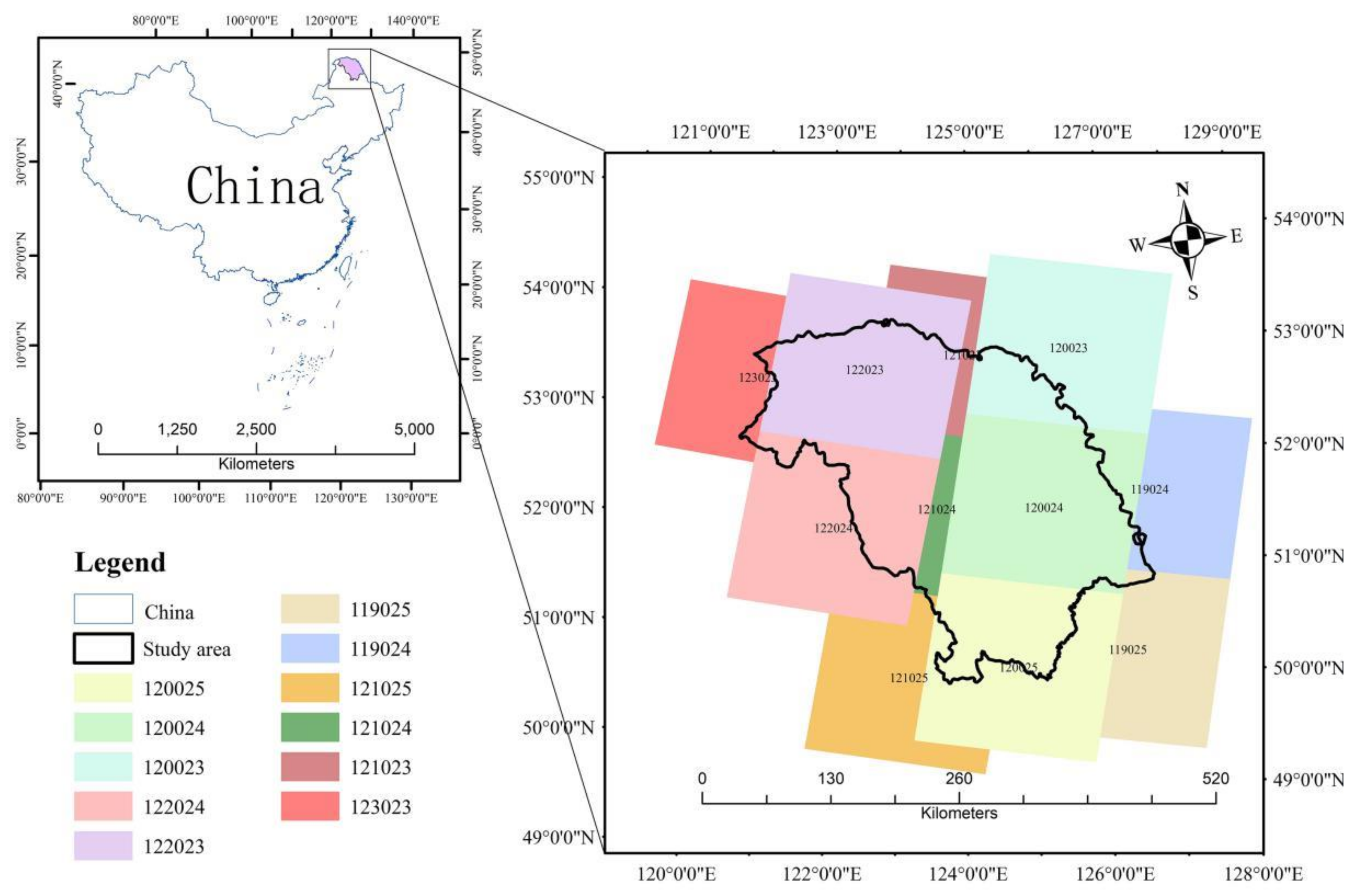
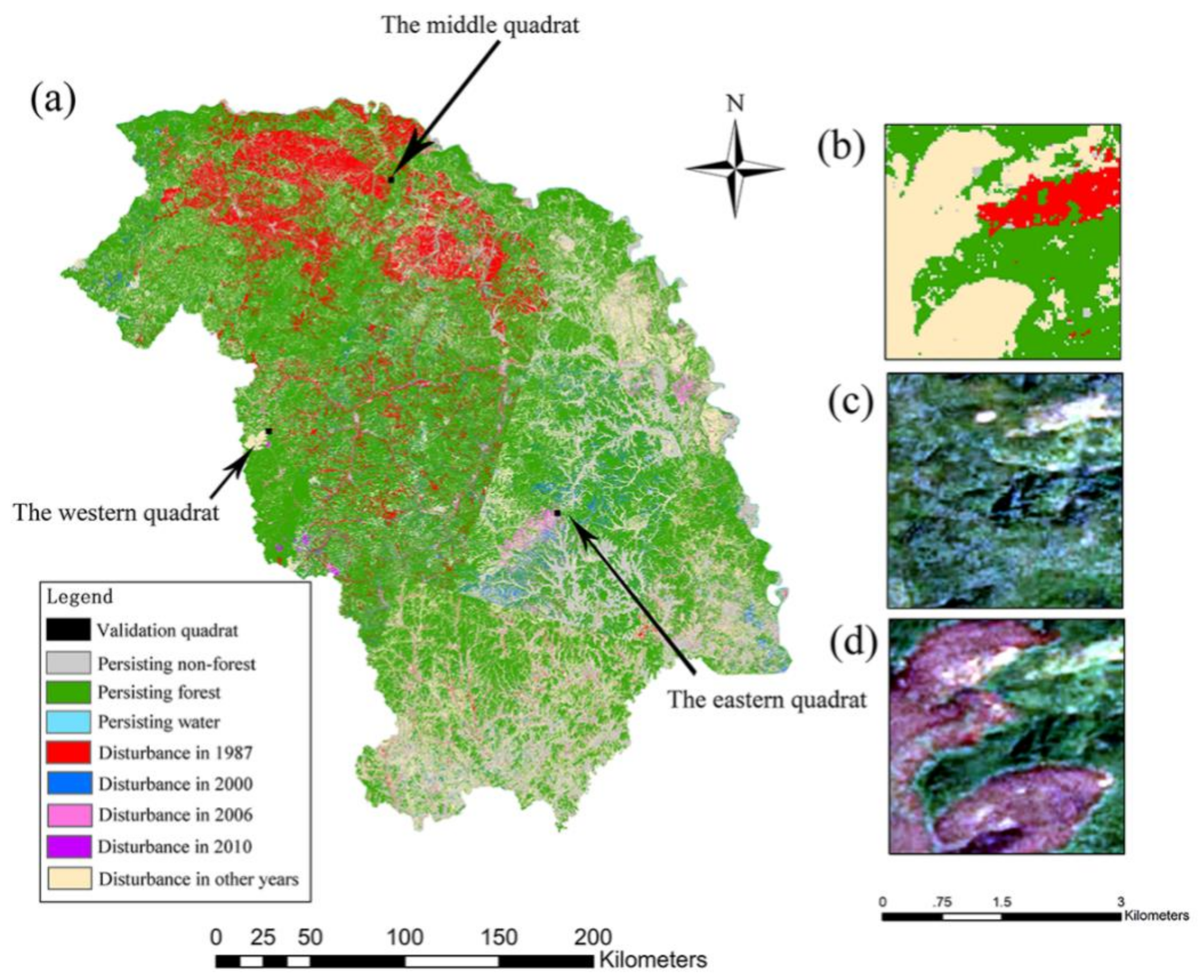
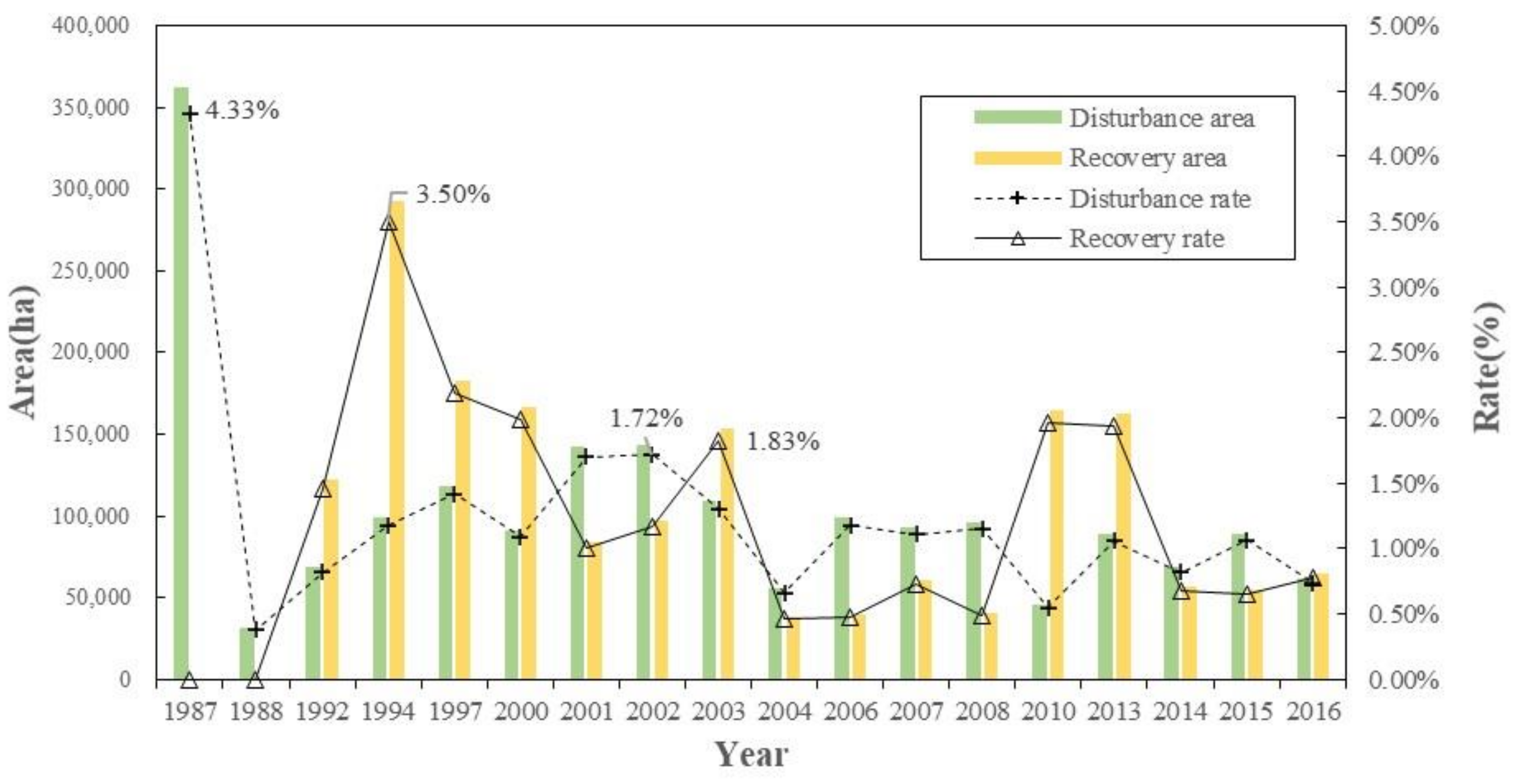
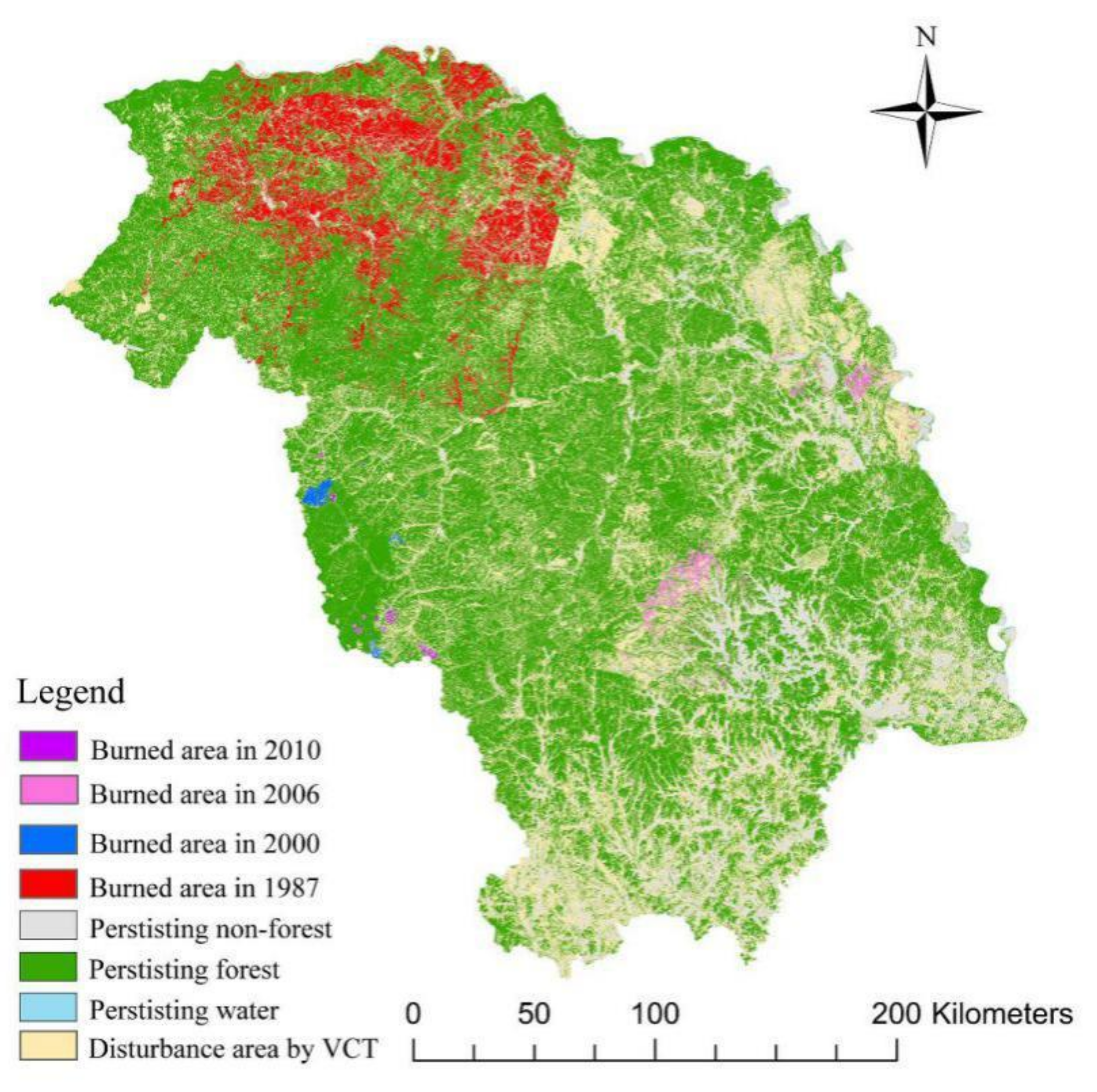
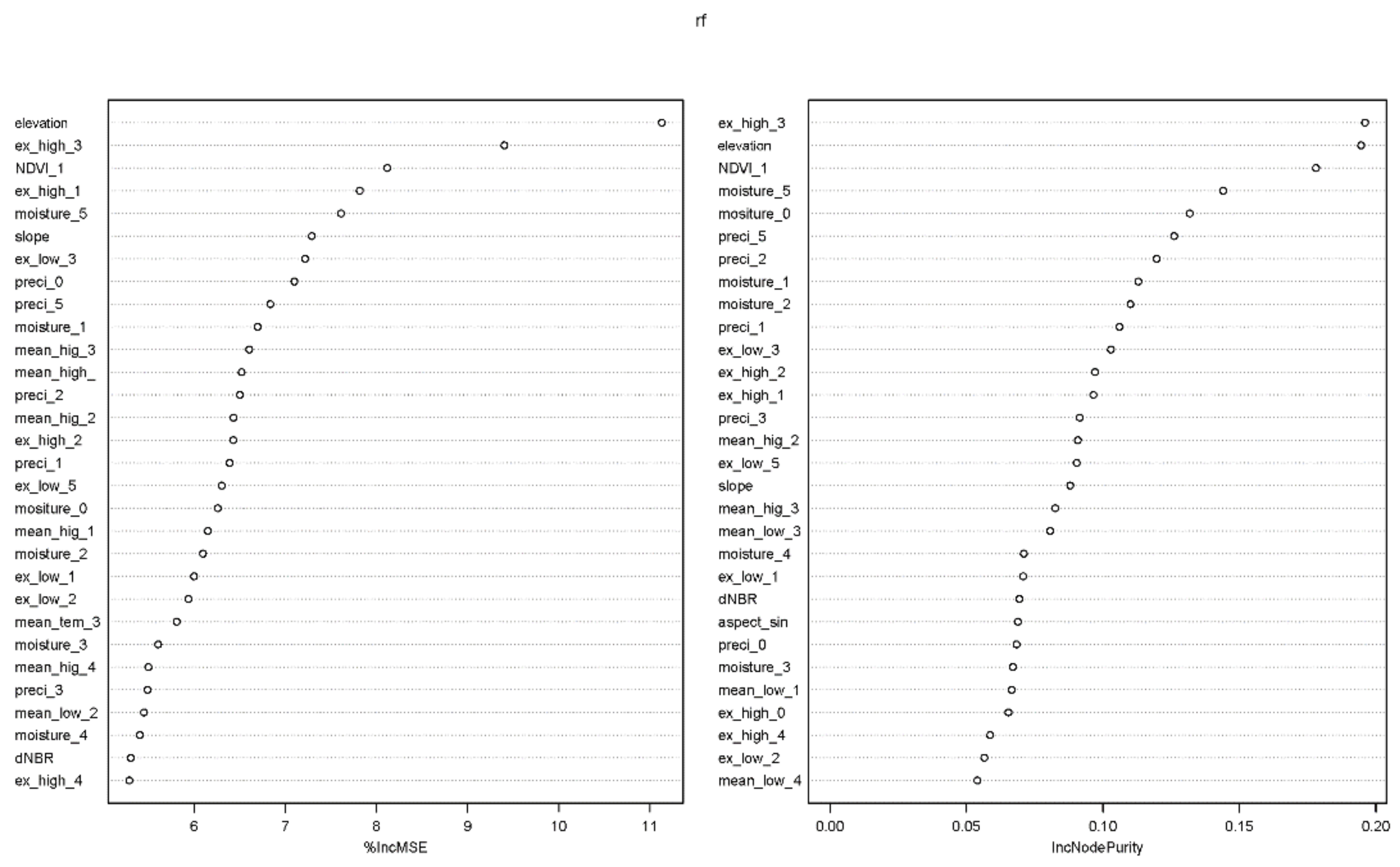
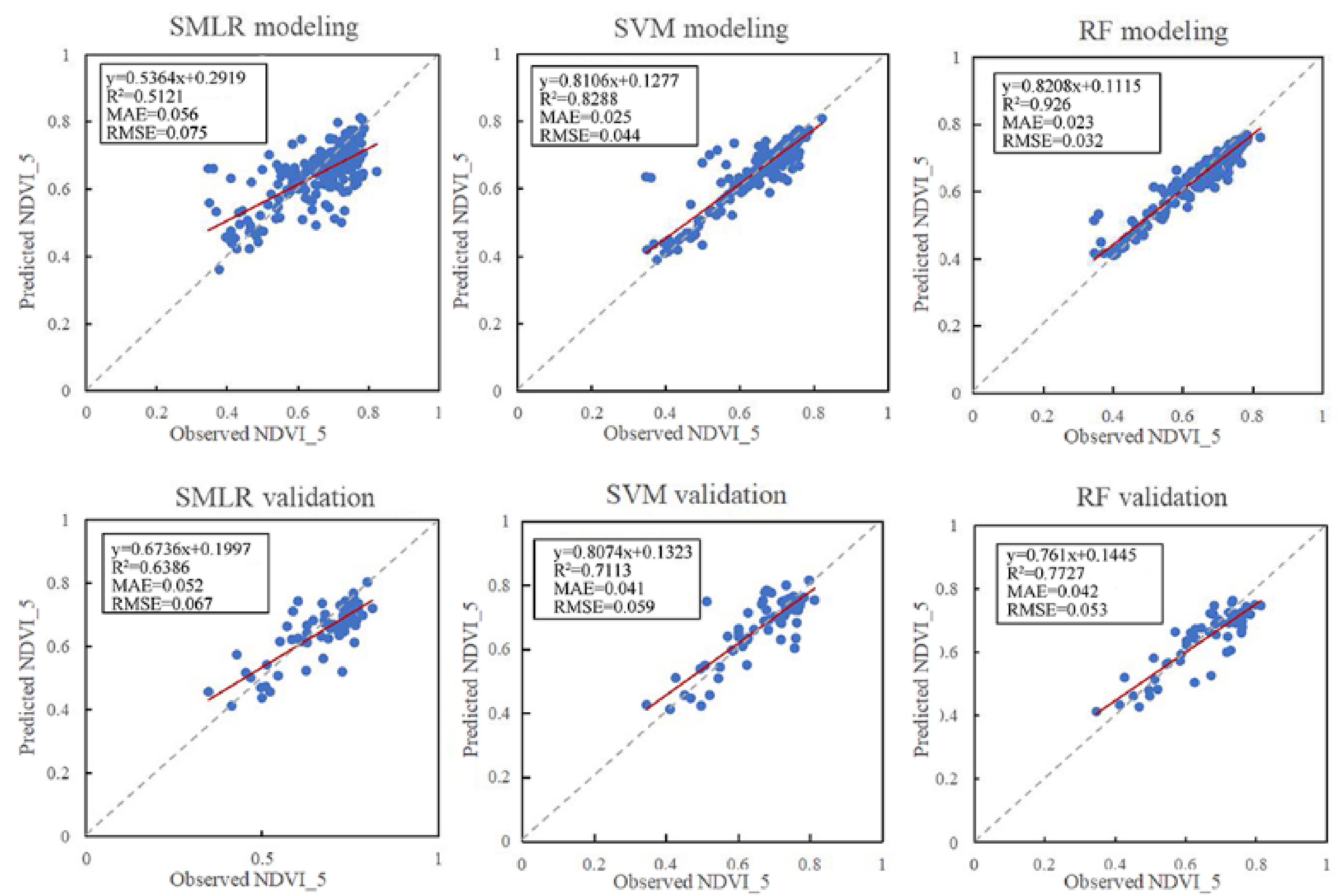
| Year | 1987 | 2000 | 2006 | 2010 |
|---|---|---|---|---|
| Number of burned pixels | 429 | 596 | 311 | 554 |
| Number of non-burned pixels | 422 | 611 | 341 | 557 |
| Total | 851 | 1207 | 652 | 1111 |
| Type | Variable | Unit | Description |
|---|---|---|---|
| Dependent variable | Post-fire NDVI of the burned area in the fifth year (NDVI_5). | Reflects vegetation restoration status after fire. | |
| Disturbance effect | Post-fire NDVI of the burned area in the first year (NDVI_1). | Reflects site conditions (initial growth conditions and remaining trees). | |
| dNBR | Reflects the fire disturbance severity. | ||
| Terrain factors | Elevation | Meter | Elevation |
| Slope | Degree | Slope | |
| Aspect_cos | Slope cosine | ||
| Aspect_sin | Slope sine | ||
| Climate factors | mean_tem_0, mean_tem_1, mean_tem_2, mean_tem_3, mean_tem_4, mean_tem_5, | Values*10 | Average annual temperature from the year of the fire (*_0) to the fifth year (*_5) after the fire in the burned area. |
| ex_high_0, ex_high_1, ex_high_2, ex_high_3, ex_high_4, ex_high_5 | Extreme maximum temperature from the year of the fire (*_0) to the fifth year (*_5). | ||
| ex_low_0, ex_low_1, ex_low_2, ex_low_3, ex_low_4, ex_low_5 | Extreme minimum temperature from the year of the fire (*_0) to the fifth year (*_5). | ||
| mean_high_0, mean_high_1, mean_high_2, mean_high_3, mean_high_4, mean_high_5 | Average maximum temperature from the year of the fire (*_0) to the fifth year (*_5) after the fire in the burned area. | ||
| mean_low_0, mean_low_1, mean_low_2, mean_low_3, mean_low_4, mean_low_5 | Average lowest temperature from the year of the fire (*_0) to the fifth year (*_5) after the fire in the burned area. | ||
| moisture_0, moisture_1, moisture_2, moisture_3, moisture_4, moisture_5 | Average relative humidity from the year of the fire (*_0) to the fifth year (*_5) after the fire in the burned area. | ||
| preci_0, preci_1, preci_2, preci_3, preci_4, preci_5 | Annual precipitation from the year of the fire (*_0) to the fifth year (*_5) after the fire. |
| Eastern Quadrat | Middle Quadrat | Western Quadrat | |||
|---|---|---|---|---|---|
| Disturbance Year | Spatial Agreement (%) | Disturbance Year | Spatial Agreement (%) | Disturbance Year | Spatial Agreement (%) |
| 1987 | 72.35 | 1987 | 91.50 | 1987 | 78.15 |
| 1988 | 76.31 | 1988 | 74.34 | 1988 | No disturbance |
| 1992 | No disturbance | 1992 | 80.82 | 1992 | 69.31 |
| 1994 | 78.66 | 1994 | No disturbance | 1994 | 61.01 |
| 1997 | 69.53 | 1997 | 70.00 | 1997 | 72.54 |
| 2000 | 62.31 | 2000 | No disturbance | 2000 | 61.44 |
| 2001 | No disturbance | 2001 | 75.93 | 2001 | 77.89 |
| 2002 | 89.53 | 2002 | 60.57 | 2002 | 89.63 |
| 2004 | 78.43 | 2004 | No disturbance | 2004 | No-disturbance |
| 2006 | 66.16 | 2006 | 74.24 | 2006 | 74.92 |
| 2007 | No disturbance | 2007 | 79.42 | 2007 | 70.08 |
| 2008 | No-disturbance | 2008 | 73.91 | 2008 | 72.25 |
| 2010 | 66.82 | 2010 | No disturbance | 2010 | 60.03 |
| 2011 | No disturbance | 2011 | 73.40 | 2011 | 71.30 |
| 2013 | 76.61 | 2013 | 73.93 | 2013 | 71.65 |
| 2014 | 71.52 | 2014 | 78.34 | 2014 | 70.81 |
| 2015 | No disturbance | 2015 | No disturbance | 2015 | No disturbance |
| 2016 | No disturbance | 2016 | No disturbance | 2016 | No disturbance |
| Year | Class | Producer’s Accuracy | User’s Accuracy | Overall Classification Accuracy | Kappa Coefficient |
|---|---|---|---|---|---|
| 1987 | Burned area | 100% | 93.9% | 95.2% | 0.905 |
| Non-burned area | 90.3% | 100% | |||
| 2000 | Burned area | 98.7% | 94.9% | 96.6% | 0.932 |
| Non-burned area | 94.4% | 98.6% | |||
| 2006 | Burned area | 98.7% | 90.3% | 93.9% | 0.877 |
| Non-burned area | 88.9% | 98.5% | |||
| 2010 | Burned area | 97.3% | 92.5% | 94.6% | 0.891 |
| Non-burned area | 91.7% | 97.1% |
| Variables | Pearson Correlation Coefficient between the Selected Variables and NDVI_5 | Estimate | Std. Error | t-Value | Pr(>|t|) |
|---|---|---|---|---|---|
| Intercept | 2.3600141 | 5.7696782 | 0.409 | 0.682871 | |
| NDVI_1 | 0.393 | 0.2944953 | 0.0790936 | 3.723 | 0.000244 |
| mean_high_0 | 0.300 | 0.1781534 | 0.0318728 | 5.59 | 6.08 × 10−8 |
| mositure_0 | 0.350 | −0.4454323 | 0.0819126 | −5.438 | 1.31 × 10−7 |
| preci_1 | 0.397 | 0.0004342 | 0.0002006 | 2.164 | 0.031432 |
| ex_low_2 | 0.208 | 0.0289014 | 0.0103279 | 2.798 | 0.005546 |
| ex_high_3 | 0.341 | 0.0879369 | 0.0231587 | 3.797 | 0.000185 |
| mean_low_3 | 0.198 | −0.0991507 | 0.0289456 | −3.425 | 0.00072 |
| preci_3 | 0.257 | −0.0002626 | 0.0001646 | −1.595 | 0.111959 |
| mean_high_4 | 0.197 | −0.1237221 | 0.0232963 | −5.311 | 2.46 × 10−7 |
| elevation | 0.451 | −0.0002075 | 0.0001024 | −2.027 | 0.043704 |
| slope | 0.261 | −0.004464 | 0.0020547 | −2.173 | 0.030774 |
Publisher’s Note: MDPI stays neutral with regard to jurisdictional claims in published maps and institutional affiliations. |
© 2021 by the authors. Licensee MDPI, Basel, Switzerland. This article is an open access article distributed under the terms and conditions of the Creative Commons Attribution (CC BY) license (http://creativecommons.org/licenses/by/4.0/).
Share and Cite
Qiu, J.; Wang, H.; Shen, W.; Zhang, Y.; Su, H.; Li, M. Quantifying Forest Fire and Post-Fire Vegetation Recovery in the Daxin’anling Area of Northeastern China Using Landsat Time-Series Data and Machine Learning. Remote Sens. 2021, 13, 792. https://doi.org/10.3390/rs13040792
Qiu J, Wang H, Shen W, Zhang Y, Su H, Li M. Quantifying Forest Fire and Post-Fire Vegetation Recovery in the Daxin’anling Area of Northeastern China Using Landsat Time-Series Data and Machine Learning. Remote Sensing. 2021; 13(4):792. https://doi.org/10.3390/rs13040792
Chicago/Turabian StyleQiu, Jie, Heng Wang, Wenjuan Shen, Yali Zhang, Huiyi Su, and Mingshi Li. 2021. "Quantifying Forest Fire and Post-Fire Vegetation Recovery in the Daxin’anling Area of Northeastern China Using Landsat Time-Series Data and Machine Learning" Remote Sensing 13, no. 4: 792. https://doi.org/10.3390/rs13040792
APA StyleQiu, J., Wang, H., Shen, W., Zhang, Y., Su, H., & Li, M. (2021). Quantifying Forest Fire and Post-Fire Vegetation Recovery in the Daxin’anling Area of Northeastern China Using Landsat Time-Series Data and Machine Learning. Remote Sensing, 13(4), 792. https://doi.org/10.3390/rs13040792








